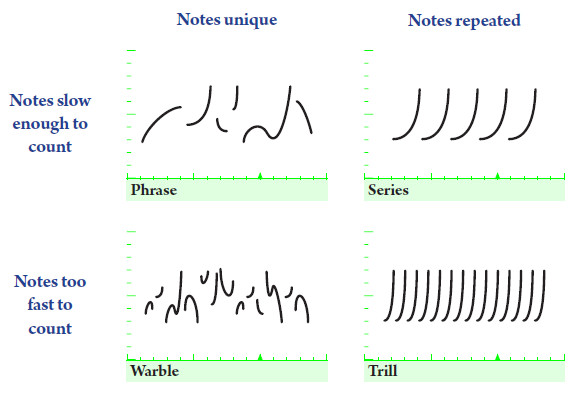The Four Basic Song Patterns
In the last post, I covered the five basic pitch patterns, introducing some vocabulary to help distinguish between different types of individual notes. Today I’m going to introduce some vocabulary to help distinguish between different types of groups of notes — that is, different types of songs.
The four song patterns are based on two simple questions:
- Does the bird ever sing the same thing twice?
- Are the notes slow enough to count, or too fast to count?
Together, these two questions delineate four basic patterns: phrases, series, warbles, and trills. These four simple patterns, individually and in combination, give us a precise way to describe almost any type of complex bird sound.
- Phrases are clusters of unique notes that are slow enough to count;
- Series are clusters of repeated notes that are slow enough to count;
- Warbles are clusters of unique notes that are too fast to count;
- Trills are clusters of repeated notes that are too fast to count.
“Too fast to count” is a somewhat subjective criterion, but as a general rule of thumb, it’s any speed over about 8 notes per second. Here are some examples of each pattern, so you can practice hearing the differences.
Phrases
In these examples, each note is different from the one before, and the notes are slow enough to count.
Series
In these examples, each note is the same as the one before, and the notes are slow enough to count.
Warbles
In these examples, the notes are all different, and too fast to count.
Trills
In these examples, the notes are all the same, and too fast to count.
In the next installment in this series, we’ll look at some ways to combine and extend this vocabulary to cover almost any type of bird sound pattern.

4 thoughts on “The Four Basic Song Patterns”
Excellent explanations with good examples. I look forward to this continuing series. I think this builds well on your previous post; will be interested to see what comes next.
Nathan: Somehow I missed this excellent series of posts until now. If it isn’t too late, I have a question about your categories. I have always thought of the notes repeated category as progressing from a chatter (countable) to a trill, a buzz, and noise, with each stage representing more closely spaced notes (culminating in noise, with no space between notes). Do you consider a buzz to be a fast trill in your system? Would you ever describe a song as having a buzz?
Thanks,
Bruce Rideout
La Mesa, CA
Hi Bruce,
Good questions. Some of the answers deal with tone quality rather than pattern, and the answers to those should become clearer with the next few posts.
In short: a “chatter” is a particular type of series or trill, one in which the individual notes are noisy (or nasal, or a combination of noisy and nasal — depends on who’s using the word “chatter”). A “buzz” is a different type of trill, one in which the notes are unmusical whistles or click-like notes. In general, faster trills are more likely to sound buzzy, but speed alone does not make a buzz — note shape is a huge factor.
More on this to come!
Thanks Nathan!
Comments are closed.